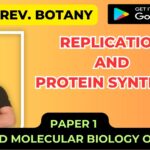![]()
CHROMOSOMES
- Chromosomes are rod-like or filamentous bodies, which are typically present in the nucleus and become visible during the stage of cell division.
- Presence of true chromosomes is the characteristic of eukaryotic cells.
- Literally, the term chromosomes have been derived from two Greek words; Chroma and soma meaning ‘colored body’.
- This is named because they appear as darkly stained bodies during cell division when stained with a suitable dye and viewed under compound microscope.
- Chromosomes can well be defined in following way “Chromosomes are individual protoplasmic entities found in the nuclei of almost all eukaryotic cells which multiply themselves through sequential cell divisions and provide physiological and morphological stability to protoplasm and so to a particular individual”
- Chromosomes were first observed by Straburger (1875) in mitotically dividing cells and the name ‘chromosome’ was proposed by Waldeyer in 1888.
- Each species has a definite and constant number of chromosomes in their cells.
- The chromosome number found in somatic cells of the species is called somatic chromosome number and is usually represented by ‘2n’. This is because, ordinarily, somatic cells contain two copies of each chromosome which are morphologically identical and also have the same gene content and gene location.
- They are known as homologous chromosomes.
- Chromosomes can darkly be stained by treating the dividing cells by acetocarmine, aceto-Orcein, fuelgen and some other basic dyes.
- In the plant kingdom, the lowest number of chromosomes is found in Haplopappus gracilis and highest in Ophioglossum reticulatum.
- In the animal kingdom, Ascaris mega-locafella has been found to have the lowest number of chromosomes.
- Chromosomes are chemically nucleio protein consisting of DNA and proteins.
- The bear genes therefore, regarded as ‘bearer of heredity.’
- Each chromosome is made up of two longitudinally held chromatids which are visible during mitotic metaphase.
- The two chromatids of a chromosome are joined at centromere, the main function of which is the formation of spindle fibers during cell division.
- Nucleolus within nucleus is associated with secondary constriction of chromosomes. Therefore, the latter is called ‘nucleolar organizer.













